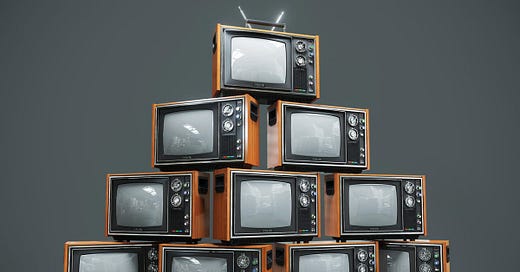You Are Not Going Deaf. TV Sound is Getting Worse.
Here are the actual reasons you need the captions these days.
The moment comes that you have been working towards all day. You settle into the dent in the couch that’s formed itself around your habits, TV remote (that took you five minutes to locate) in one hand, something to drink (that feels like a treat) in the other, and your first order of business is to you toggle the “CC” icon on. You don’t even think about it anymore.
Once upon a time you did. The first time you missed a line of dialogue. Then the third. Then the eighth. You paused the show. You rewound. You played it again. The sound of the wind came through clearly. So did the rustling leaves, the ominous cello, the ambient threat of whatever was about to happen. You could hear everything... but the words.
You asked yourself if you were going deaf. You looked up the symptoms on WebMD. You thought about the inevitably of your perishing. But, as it turns out, you are not the only one. Yes, you are going to die but that's not why you can't hear the TV. There are actual reasons, things that have changed, it isn't just you.
The Sound of Closeness
One of the first things that changed was the way people talk on screen. This has been going on for most of the current century.
Think back to FRIENDS or ER or BUFFY THE VAMPIRE SLAYER. In the 90's used to be able to hear people on TV. That’s not nostalgia talking. That’s memory, which is different. There was projection. Breath support. Diction. You could close your eyes and still follow what was happening. You could fold laundry without feeling like you were trying to hear conversation in a crowded coffee shop three tables away.
There were reasons why actors learned to project. They said their lines as though they needed to reach the last row of a theater or TV audience. But now they whisper. They murmur. They act with their eyelashes. Television as a medium has moved in a direction that feels more "real".
This is not a failing. It’s a style. It reflects something true: the longing for intimacy, for realism, for the sense that we are not watching actors, but eavesdropping on people who exist and are fragile and sometimes afraid. It is the sound of closeness, of interiority.
But these performances, as beautiful as they often are, are also vulnerable to being lost. They do not survive the conversion into digital media. They rarely survive your television speakers. Even with good headphones we are struggling. But in a living room, with the dishwasher humming or a truck passing outside, the voices disappear.
Compression for Streaming
It is important to remember that technically, you are not watching a show. You’re watching a digital file, a compressed and encoded stream of data optimized for the particular limitations of your device, your network, your connection at that moment.
Compression settings decide what is essential. They’re very good at preserving what we think of as sensation: the big sounds, the bass, the textures. What they are not good at is preserving subtlety.
What disappears is the human voice.
Compression looks at waveforms and makes decisions. It does not know what words are. It does not know you need them. It does not know you’re trying to understand a story. This is what we’ve optimized it for. Not clarity. Not connection. But continuity. Smooth playback. A seamless watching experience. You may not understand a lick about what’s happening in the scene, but at least it won’t buffer.
The streaming service says, “Hey, we’re trying to deliver this episode to four hundred million people, including two dudes on a fishing boat with bad 5G on Lake Lanier. That’s a lot of data. We need to compress this audio so it doesn’t clog the pipes.”
And compress they do! They squish and flatten the dynamic range. They discard “extraneous” frequencies. The human voice is tricky. It lives in a very narrow frequency band. It’s soft, it’s subtle, it’s full of emotion, and it doesn’t stand a chance against a CGI skyscraper crumbling in surround sound. So it gets buried. Muffled. Squeezed.
And you, noble viewer, sit there with your thumb on the volume button:
Up, up, up to hear them talk.
Down, down, down, to survive the gunfire.
Up, up, up for the whisper.
Down for the 100 person choir and orchestra.
You are not going deaf. You are playing a game of audio whack-a-mole.
The Problem Behind the Symptom
Closed captions are not a solution. They are an adaptation. A symptom. We say, “I just leave them on, it’s easier.” We think of it as convenience, but it is really the white flag of surrender.
So now now read our TV shows like novels.
(While, ironically, we listen to our audiobook novels like radio plays)
But there is a bigger problem behind the symptom. There is an ominous cultural shift of priorities from our corporate overlords and it is this:






